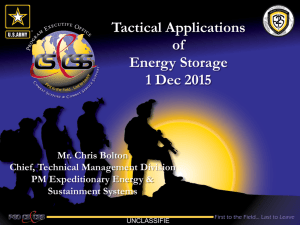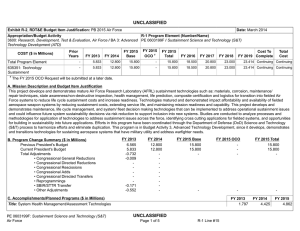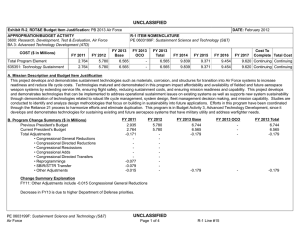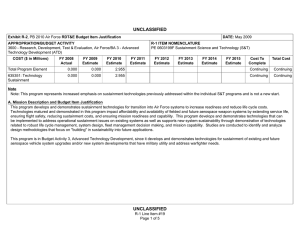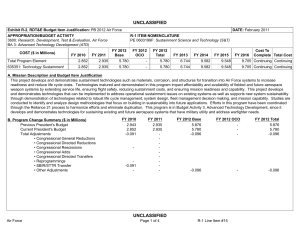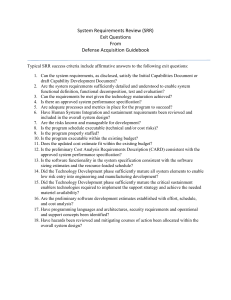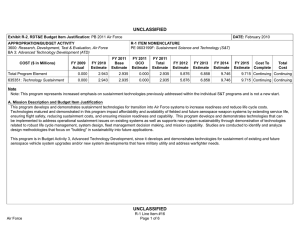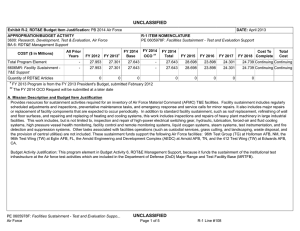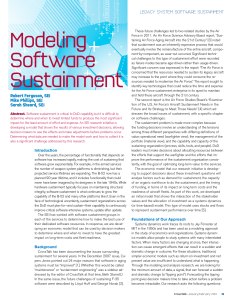UNCLASSIFIED
advertisement
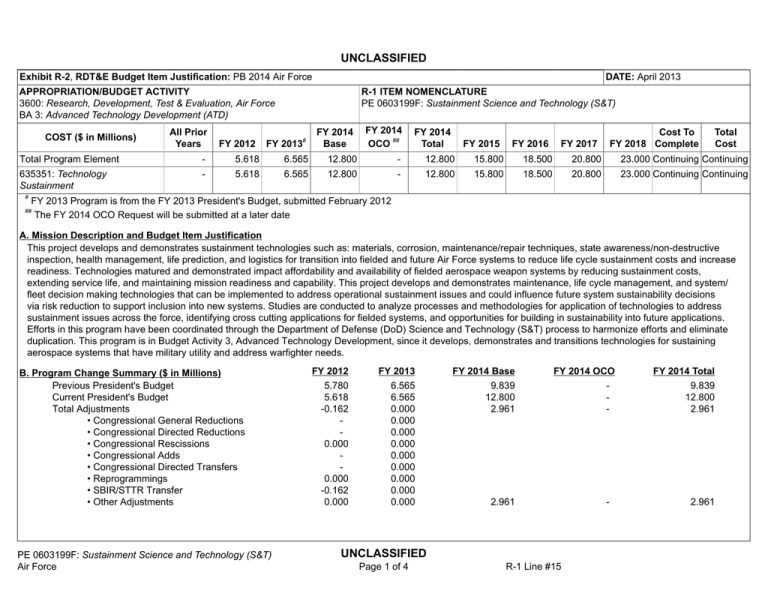
UNCLASSIFIED DATE: April 2013 Exhibit R-2, RDT&E Budget Item Justification: PB 2014 Air Force APPROPRIATION/BUDGET ACTIVITY 3600: Research, Development, Test & Evaluation, Air Force BA 3: Advanced Technology Development (ATD) COST ($ in Millions) All Prior Years FY 2012 R-1 ITEM NOMENCLATURE PE 0603199F: Sustainment Science and Technology (S&T) # FY 2013 FY 2014 Base FY 2014 ## OCO FY 2014 Total FY 2015 FY 2016 FY 2017 Cost To FY 2018 Complete Total Cost Total Program Element - 5.618 6.565 12.800 - 12.800 15.800 18.500 20.800 23.000 Continuing Continuing 635351: Technology Sustainment - 5.618 6.565 12.800 - 12.800 15.800 18.500 20.800 23.000 Continuing Continuing # FY 2013 Program is from the FY 2013 President's Budget, submitted February 2012 The FY 2014 OCO Request will be submitted at a later date ## A. Mission Description and Budget Item Justification This project develops and demonstrates sustainment technologies such as: materials, corrosion, maintenance/repair techniques, state awareness/non-destructive inspection, health management, life prediction, and logistics for transition into fielded and future Air Force systems to reduce life cycle sustainment costs and increase readiness. Technologies matured and demonstrated impact affordability and availability of fielded aerospace weapon systems by reducing sustainment costs, extending service life, and maintaining mission readiness and capability. This project develops and demonstrates maintenance, life cycle management, and system/ fleet decision making technologies that can be implemented to address operational sustainment issues and could influence future system sustainability decisions via risk reduction to support inclusion into new systems. Studies are conducted to analyze processes and methodologies for application of technologies to address sustainment issues across the force, identifying cross cutting applications for fielded systems, and opportunities for building in sustainability into future applications. Efforts in this program have been coordinated through the Department of Defense (DoD) Science and Technology (S&T) process to harmonize efforts and eliminate duplication. This program is in Budget Activity 3, Advanced Technology Development, since it develops, demonstrates and transitions technologies for sustaining aerospace systems that have military utility and address warfighter needs. B. Program Change Summary ($ in Millions) Previous President's Budget Current President's Budget Total Adjustments • Congressional General Reductions • Congressional Directed Reductions • Congressional Rescissions • Congressional Adds • Congressional Directed Transfers • Reprogrammings • SBIR/STTR Transfer • Other Adjustments PE 0603199F: Sustainment Science and Technology (S&T) Air Force FY 2012 FY 2013 FY 2014 Base FY 2014 OCO FY 2014 Total 5.780 5.618 -0.162 - - 0.000 - - 0.000 -0.162 0.000 6.565 6.565 0.000 0.000 0.000 0.000 0.000 0.000 0.000 0.000 0.000 9.839 12.800 2.961 - - - 9.839 12.800 2.961 2.961 - 2.961 UNCLASSIFIED Page 1 of 4 R-1 Line #15 UNCLASSIFIED DATE: April 2013 Exhibit R-2, RDT&E Budget Item Justification: PB 2014 Air Force APPROPRIATION/BUDGET ACTIVITY 3600: Research, Development, Test & Evaluation, Air Force BA 3: Advanced Technology Development (ATD) R-1 ITEM NOMENCLATURE PE 0603199F: Sustainment Science and Technology (S&T) Change Summary Explanation Increase in FY14 is due to increased DoD emphasis on sustainment. C. Accomplishments/Planned Programs ($ in Millions) Title: System Health Management/Assessment Technologies FY 2012 2.788 FY 2013 2.023 FY 2014 4.425 0.886 2.527 5.340 Description: Develop, demonstrate, and transition state awareness/system health management technologies. Conduct studies and analyses to design sustainability into future applications. FY 2012 Accomplishments: Validated model to verify F-22 wing lug residual stress treatments which enable a 4X-6X life extension. Developed, demonstrated, and transitioned color changing tape and passive RFID technologies for KC-135 fuel bladder leak detection. Developed and transitioned an ultrasonic inspection NDI procedure to detect cracks on KC-135 wing terminal fitting flange, saving numerous man hours on wing inspections. Demonstrated and transitioned capability to virtually re-inspect fielded engine rotors to identify parts incorrectly passed during overhaul, avoiding 13 engine teardowns and maintaining six aircraft in service. FY 2013 Plans: Continue verification of state-of-the-art algorithms and techniques to assess health and real-time awareness for weapon system components. Continue to develop life prediction models for extending component life, and to demonstrate and incorporate health assessment technologies into sustainment operations. Complete validation of eddy current non-destructive inspection (NDI) techniques for multiple aircraft for field and depot level inspections, which will improve crack detection in multiple layers of material and beneath fasteners. Initiate efforts to monitor/assess health of airframe/engine, wiring insulation and oil. FY 2014 Plans: Continue efforts to demonstrate and validate algorithms and techniques for system assessment and health management. Initiate quantification of life extension prediction of A-10 and T-38 aircraft cold worked holes, development of active fuel bladder leak detection capability, and health assessment capability development for fielded systems and components. Continue development and demonstration of diagnostic technology to monitor/assess health of airframe/engine, wiring insulation, and oil. Title: Prevention/Enhanced Maintainability Technologies Description: Develop, demonstrate, and transition technologies to improve component design, maintenance, replacement, and concepts for performance improvement and reduced maintenance burden. FY 2012 Accomplishments: Completed demonstration of a new Aluminum alloy and innovative process to replace end fittings for C-5 floor bulkhead, resulting in 80% reduction in fabrication time, and 60% increase in service life. Installed on aircraft Nov 2011. Completed PE 0603199F: Sustainment Science and Technology (S&T) Air Force UNCLASSIFIED Page 2 of 4 R-1 Line #15 UNCLASSIFIED DATE: April 2013 Exhibit R-2, RDT&E Budget Item Justification: PB 2014 Air Force APPROPRIATION/BUDGET ACTIVITY 3600: Research, Development, Test & Evaluation, Air Force BA 3: Advanced Technology Development (ATD) R-1 ITEM NOMENCLATURE PE 0603199F: Sustainment Science and Technology (S&T) C. Accomplishments/Planned Programs ($ in Millions) commercialization of powered gap filler removal tools for F-22 and B-2, demonstrated 50% man-hour savings, reducing field/depot maintenance costs and worker injuries. FY 2012 FY 2013 FY 2014 FY 2013 Plans: Continue efforts to develop life enhancement/replacement/repair technologies and demonstrate high reliability solutions. Initiate efforts to develop honeycomb replacement alternatives for the C-5 and a two-fold increase in Mean Time Between Failure (MTBF) for the MQ-1 Predator sensor cryo-coolers. Complete: Residual stress surface treatment approach, enabling a threefold extension of the A-10 aircraft wing splice life; Design, validate and manufacture aluminum hybrid alternative for A-10 longeron strap replacement to support airframe service life extension; and demonstrate engine component technologies to enable conversion of MQ-1 Predator engines from AVGAS to JP-8, increasing safety, saving cost of fuel, and increasing engine durability by 10%. FY 2014 Plans: Continue efforts to demonstrate high reliability repair and maintenance technologies to increase service time between maintenance actions. Continue maturation of airframe/engine/subsystem technologies including replacement for honeycomb structures, demonstration of a two-fold increase in MQ-1 Predator sensor cryocoolers, and validation of erosion coating test protocol for improved component durability, reliability, and safety to increase time between maintenance actions and reduce maintenance cost drivers. Initiate demonstration of a solid state amplifier replacement for unsupportable vacuum tubes used on the B-1 aircraft's ALQ-161, defensive avionics system. Title: Management/Improved Reliability Technologies 1.944 Description: Develop, demonstrate, and transition technologies to improve existing and new components, fleet management/ decision-making tools, and supply chain/sustainment infrastructure to decrease downtime, costs, and increase reliability. FY 2012 Accomplishments: Designed, developed and demonstrated new digital fuel quantity indicator technology for C-130 that increases life and provides a more viable and reliable fuel reading. Demonstrated operational benefit of engine health monitoring system fault resolution tool to ID faulty/broken components to resolve issues on fielded jets. Initiated F-15C/D Stick-to-Stress Real-Time Simulator Tool to provide for more accurate & rapid analysis tool to manage unexpected new cracking locations. FY 2013 Plans: Continue to evaluate technological means to adjust system management and operational sustainment requirements. Initiate effort to demonstrate probabilistic approach to engine component life management to eliminate some inspection requirements or increase inspection intervals, reducing engine overhaul costs. Initiate effort to reduce Fuel System Icing Inhibitor levels in JP-8, PE 0603199F: Sustainment Science and Technology (S&T) Air Force UNCLASSIFIED Page 3 of 4 R-1 Line #15 2.015 3.035 UNCLASSIFIED DATE: April 2013 Exhibit R-2, RDT&E Budget Item Justification: PB 2014 Air Force APPROPRIATION/BUDGET ACTIVITY 3600: Research, Development, Test & Evaluation, Air Force BA 3: Advanced Technology Development (ATD) R-1 ITEM NOMENCLATURE PE 0603199F: Sustainment Science and Technology (S&T) C. Accomplishments/Planned Programs ($ in Millions) reducing costs of additive and maintenance due to fuel tank coat peeling in the B-52 aircraft. Complete validated F-15C/D Stick-toStress Real-Time Simulator Tool to provide for more accurate & rapid analysis tool to manage unexpected new cracking locations. FY 2012 FY 2013 FY 2014 FY 2014 Plans: Continue efforts to develop system fleet management decision-making tools, repair data base technologies and techniques, and supply chain/infrastructure approaches to reduce sustainment costs. Continue efforts to: develop and demonstrate a probabilistic approach to determine fatigue life limits of engine components to revise inspection and replacement intervals to reduce sustainment costs; install a single depot level software architecture for engine part actuarial processes; develop and validate a corrosion severity/time model for hot spots on the C-5 to improve anticipation and management of corrosion damage. Continue probabilistic approach to component life management and effort to reduce icing inhibitor levels in JP-8. Accomplishments/Planned Programs Subtotals 5.618 6.565 12.800 D. Other Program Funding Summary ($ in Millions) N/A Remarks E. Acquisition Strategy Not Applicable. F. Performance Metrics Please refer to the Performance Base Budget Overview Book for information on how Air Force resources are applied and how those resources are contributing to Air Force performance goals and most importantly, how they contribute to our mission. PE 0603199F: Sustainment Science and Technology (S&T) Air Force UNCLASSIFIED Page 4 of 4 R-1 Line #15
